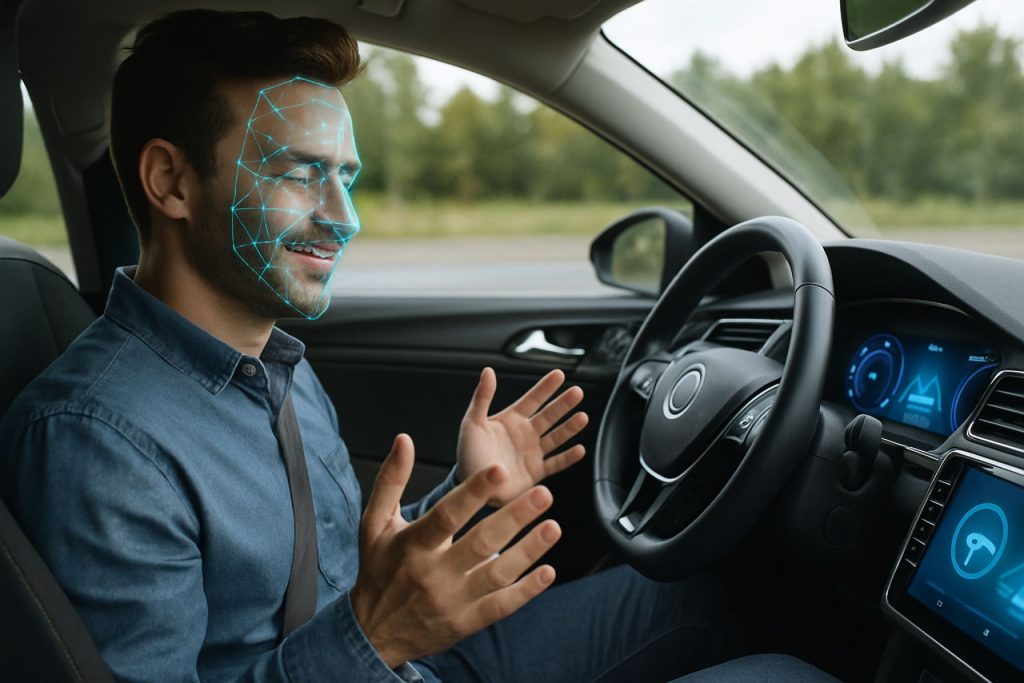
Emotion Recognition AI for Autonomous Vehicles 2025: Market Dynamics, Growth Projections, and Strategic Insights. Explore Key Trends, Regional Leaders, and Opportunities Shaping the Next Five Years.
- Executive Summary & Market Overview
- Key Technology Trends in Emotion Recognition AI
- Competitive Landscape and Leading Players
- Market Growth Forecasts and Revenue Projections (2025–2030)
- Regional Analysis: Adoption and Investment Hotspots
- Challenges, Risks, and Emerging Opportunities
- Future Outlook: Innovation Pathways and Strategic Recommendations
- Sources & References
Executive Summary & Market Overview
Emotion Recognition AI for Autonomous Vehicles represents a rapidly evolving segment within the broader automotive AI and advanced driver-assistance systems (ADAS) market. This technology leverages computer vision, machine learning, and sensor fusion to detect and interpret the emotional and cognitive states of drivers and, in some cases, passengers. The primary objective is to enhance safety, personalize in-car experiences, and support the transition toward higher levels of vehicle autonomy.
In 2025, the global market for Emotion Recognition AI in autonomous vehicles is projected to experience robust growth, driven by increasing regulatory focus on road safety, consumer demand for advanced in-cabin features, and the automotive industry’s push toward fully autonomous vehicles. According to International Data Corporation (IDC), the integration of AI-driven emotion recognition systems is expected to become a standard feature in new vehicle models, particularly in premium and electric vehicle segments.
Key market drivers include:
- Stringent safety regulations in regions such as the EU and China, mandating driver monitoring systems to detect drowsiness and distraction (European Parliament).
- OEM partnerships with AI technology providers to accelerate the deployment of emotion recognition solutions (NVIDIA, Tesla).
- Growing consumer acceptance of in-cabin monitoring for personalized infotainment, comfort, and wellness features (McKinsey & Company).
The competitive landscape is characterized by collaborations between automotive OEMs, Tier 1 suppliers, and AI startups. Notable players include Smart Eye, Affectiva (now part of Smart Eye), and Cogito, all of which are advancing multimodal emotion recognition platforms tailored for automotive applications.
Market challenges persist, including concerns over data privacy, the need for robust real-time processing, and the integration of emotion AI with existing vehicle architectures. However, ongoing advancements in edge computing and sensor technology are expected to mitigate these barriers. By 2025, Emotion Recognition AI is poised to play a pivotal role in the evolution of autonomous vehicles, supporting both safety-critical functions and next-generation user experiences (Gartner).
Key Technology Trends in Emotion Recognition AI
Emotion Recognition AI is rapidly emerging as a critical component in the evolution of autonomous vehicles, with 2025 poised to see significant advancements in both technology and deployment. The integration of emotion recognition systems into vehicle cabins is driven by the need to enhance safety, personalize user experience, and build trust in autonomous driving technologies.
One of the most prominent trends is the use of multimodal sensor fusion, combining data from cameras, microphones, and even wearable devices to assess driver and passenger emotional states with higher accuracy. Leading automotive suppliers such as Bosch and Continental are developing in-cabin monitoring systems that leverage computer vision and audio analysis to detect signs of stress, fatigue, distraction, or aggression. These systems use deep learning algorithms trained on large, diverse datasets to interpret subtle facial expressions, voice modulations, and physiological cues in real time.
Another key trend is the shift toward edge AI processing. To address privacy concerns and reduce latency, emotion recognition models are increasingly being deployed directly on vehicle hardware rather than relying on cloud-based analysis. Companies like NVIDIA are providing powerful automotive-grade AI chips that enable real-time emotion inference without transmitting sensitive data outside the vehicle, aligning with evolving data protection regulations in major markets.
Emotion recognition is also being integrated with advanced driver monitoring systems (DMS) to enable context-aware interventions. For example, if the AI detects signs of driver frustration or drowsiness, the vehicle can adjust cabin settings, suggest a break, or even initiate autonomous driving mode for safety. Smart Eye and Cogito are among the companies pioneering such adaptive systems, which are expected to become standard features in premium vehicles by 2025.
Finally, regulatory momentum is accelerating adoption. The European Union’s General Safety Regulation, effective from July 2024, mandates driver monitoring systems in new vehicles, indirectly boosting demand for emotion recognition capabilities. According to IDC, the global market for in-cabin sensing—including emotion AI—is projected to grow at a CAGR of over 15% through 2025, with autonomous vehicles representing a significant share of this expansion.
Competitive Landscape and Leading Players
The competitive landscape for emotion recognition AI in autonomous vehicles is rapidly evolving, driven by the convergence of advanced driver monitoring systems (DMS), in-cabin sensing, and the broader push toward safer, more personalized mobility experiences. As of 2025, the market is characterized by a mix of established automotive technology suppliers, AI startups, and major automotive OEMs integrating emotion recognition capabilities into their next-generation vehicles.
Key players in this space include Smart Eye, a pioneer in driver monitoring systems, which has expanded its portfolio to include emotion and cognitive state detection using computer vision and deep learning. Affectiva, now a part of Smart Eye, remains a leader in emotion AI, leveraging a vast dataset of human facial expressions and vocal patterns to interpret driver and passenger emotions in real time. Their technology is already being deployed in production vehicles by several global automakers.
Another significant player is Cipia (formerly Eyesight Technologies), which offers in-cabin sensing solutions that include emotion recognition as part of a broader suite of driver and occupant monitoring features. Xperi (through its subsidiary Tessera) and VisionNav are also investing in AI-driven in-cabin analytics, focusing on both safety and user experience enhancements.
Automotive OEMs such as Mercedes-Benz and BMW have begun integrating emotion recognition features into their advanced infotainment and safety systems, often through partnerships with specialized AI firms. For example, Mercedes-Benz’s MBUX system incorporates emotion-sensing capabilities to adjust in-cabin settings and provide proactive safety alerts.
- Smart Eye and Affectiva: Leading in DMS and emotion AI integration, with a strong OEM client base.
- Cipia: Focused on scalable, real-time in-cabin sensing for mass-market vehicles.
- Xperi: Expanding in-cabin analytics through partnerships and acquisitions.
- Mercedes-Benz and BMW: Early adopters of emotion recognition in commercial vehicles.
The competitive environment is expected to intensify as regulatory bodies in Europe and Asia mandate advanced driver and occupant monitoring, further incentivizing innovation and partnerships in emotion recognition AI for autonomous vehicles. Strategic collaborations, proprietary datasets, and real-time processing capabilities will be key differentiators among leading players in 2025.
Market Growth Forecasts and Revenue Projections (2025–2030)
The market for emotion recognition AI in autonomous vehicles is poised for significant growth in 2025, driven by increasing integration of advanced driver monitoring systems (DMS) and the automotive industry’s focus on enhancing in-cabin safety and user experience. According to projections by MarketsandMarkets, the global emotion detection and recognition market is expected to reach $56 billion by 2025, with a substantial share attributed to automotive applications, particularly in autonomous and semi-autonomous vehicles.
Automotive OEMs are accelerating the adoption of emotion AI to monitor driver alertness, stress, and distraction, which is critical for Level 2 and Level 3 autonomy where human intervention may still be required. The European Union’s General Safety Regulation, mandating DMS in all new vehicles from 2024, is expected to further catalyze demand in 2025, especially in the European market. IDTechEx forecasts that the automotive camera market, a key enabler for emotion AI, will surpass $8 billion in 2025, with a growing portion dedicated to in-cabin monitoring solutions.
Revenue projections for emotion recognition AI in autonomous vehicles specifically are estimated to exceed $1.2 billion globally in 2025, according to Grand View Research. North America and Europe are expected to lead, accounting for over 60% of the market share, due to early regulatory adoption and strong presence of leading automotive technology providers. Asia-Pacific, particularly China and Japan, is anticipated to witness the fastest growth, fueled by rapid advancements in smart mobility and government initiatives supporting AI integration in transportation.
Key industry players such as DENSO Corporation, Cogito, and ffectiv.ai are investing heavily in R&D to enhance the accuracy and real-time capabilities of emotion recognition systems. Partnerships between automotive OEMs and AI startups are expected to intensify in 2025, further accelerating market expansion and revenue growth.
Regional Analysis: Adoption and Investment Hotspots
The adoption and investment landscape for emotion recognition AI in autonomous vehicles is highly dynamic, with distinct regional hotspots emerging as leaders in 2025. North America, particularly the United States, continues to dominate both in terms of technological innovation and capital inflow. Major automotive and tech companies, such as Ford Motor Company and Tesla, Inc., are actively integrating emotion recognition systems to enhance in-cabin safety and user experience. The U.S. also benefits from a robust startup ecosystem and significant venture capital activity, with firms like Affectiva (acquired by Smart Eye) leading the charge in emotion AI for mobility applications.
Europe is another critical region, driven by stringent safety regulations and a strong focus on ethical AI deployment. Germany, France, and the UK are at the forefront, with automakers such as BMW Group and Mercedes-Benz Group AG piloting advanced driver monitoring systems that incorporate emotion recognition. The European Union’s General Safety Regulation, which mandates driver monitoring systems in new vehicles from 2024, is accelerating adoption and investment in this technology across the continent (European Commission).
Asia-Pacific is witnessing rapid growth, led by China, Japan, and South Korea. Chinese automakers such as Geely and tech giants like BYD are investing heavily in emotion AI to differentiate their autonomous vehicle offerings and comply with evolving safety standards. Japan’s focus on aging populations and road safety is driving collaborations between automotive OEMs and AI startups, while South Korea’s Hyundai Motor Company is integrating emotion recognition to enhance driver well-being and reduce accidents.
- North America: Innovation and investment hub, strong startup presence, regulatory support.
- Europe: Regulation-driven adoption, ethical AI focus, leading OEM pilots.
- Asia-Pacific: Fastest growth, government incentives, tech-automotive partnerships.
Overall, regional adoption and investment in emotion recognition AI for autonomous vehicles in 2025 are shaped by regulatory frameworks, local market needs, and the presence of technology leaders, with North America, Europe, and Asia-Pacific emerging as the primary hotspots.
Challenges, Risks, and Emerging Opportunities
The integration of emotion recognition AI into autonomous vehicles presents a complex landscape of challenges, risks, and emerging opportunities as the technology matures in 2025. One of the primary challenges is ensuring the accuracy and reliability of emotion detection algorithms across diverse populations and real-world driving conditions. Variations in facial expressions, cultural differences, and occlusions (such as sunglasses or masks) can significantly impact the performance of AI models, leading to potential misinterpretations that may compromise safety or user experience. Addressing these issues requires extensive, diverse datasets and continuous model refinement, which can be resource-intensive for developers and manufacturers.
Privacy and data security risks are also at the forefront. Emotion recognition systems often rely on continuous monitoring of drivers and passengers through cameras and sensors, raising concerns about the collection, storage, and potential misuse of sensitive biometric data. Regulatory frameworks, such as the EU’s General Data Protection Regulation (GDPR), are increasingly scrutinizing the deployment of such technologies, compelling automakers and AI vendors to implement robust data protection measures and transparent consent mechanisms. Failure to comply can result in significant legal and reputational repercussions, as highlighted in recent industry analyses by Gartner and IDC.
Another risk involves the integration of emotion recognition AI with existing vehicle systems. Ensuring seamless interoperability between emotion AI, driver monitoring systems, and autonomous driving modules is technically challenging. Inconsistent or delayed responses to detected emotional states—such as drowsiness or agitation—could undermine trust in autonomous vehicles and potentially lead to safety incidents. According to McKinsey & Company, automakers must prioritize real-time processing capabilities and fail-safe mechanisms to mitigate these risks.
Despite these challenges, significant opportunities are emerging. Emotion recognition AI can enhance in-cabin safety by detecting driver fatigue, distraction, or stress, enabling proactive interventions such as adjusting vehicle controls or alerting emergency services. Additionally, the technology opens new avenues for personalized in-car experiences, from adaptive infotainment to wellness features, which can differentiate brands in a competitive market. As noted by Statista, the global market for emotion AI in automotive applications is projected to grow rapidly, driven by consumer demand for smarter, safer, and more responsive vehicles.
Future Outlook: Innovation Pathways and Strategic Recommendations
The future outlook for emotion recognition AI in autonomous vehicles is shaped by rapid technological advancements, evolving regulatory landscapes, and shifting consumer expectations. By 2025, the integration of emotion recognition systems is expected to move beyond pilot projects and into broader commercial deployment, driven by the dual imperatives of safety and user experience enhancement.
Innovation pathways are likely to focus on multi-modal sensing, combining facial analysis, voice recognition, physiological monitoring, and behavioral cues to achieve higher accuracy and robustness in emotion detection. Leading automotive and technology firms are investing in sensor fusion and deep learning algorithms to interpret complex emotional states in real time, even under challenging conditions such as low lighting or partial occlusion. For example, Tesla and Bosch are exploring in-cabin monitoring systems that leverage AI to detect driver fatigue, stress, or distraction, enabling proactive safety interventions.
Strategically, partnerships between automakers, AI startups, and academic institutions are expected to accelerate innovation. Collaborative ecosystems will be crucial for developing standardized datasets, benchmarking models, and addressing privacy and ethical concerns. Regulatory bodies in the EU, US, and Asia are anticipated to introduce guidelines for in-cabin data collection and processing, emphasizing transparency and user consent. Companies that proactively align with these frameworks will gain a competitive edge and foster consumer trust.
From a market perspective, emotion recognition AI is projected to become a key differentiator in the premium and shared mobility segments. According to Gartner, by 2025, over 30% of new vehicles in developed markets may feature some form of emotion-aware technology, either as standard or optional equipment. This trend is expected to drive new revenue streams through personalized in-car services, adaptive infotainment, and insurance telematics.
- Invest in multi-modal AI research to improve emotion detection accuracy and resilience.
- Forge cross-industry partnerships to accelerate development and standardization.
- Engage proactively with regulators to shape and comply with emerging privacy standards.
- Focus on user-centric design to ensure transparency, consent, and value creation for end-users.
- Explore new business models leveraging emotion data for personalized mobility services.
In summary, the next phase of emotion recognition AI for autonomous vehicles will be defined by technological convergence, regulatory clarity, and strategic collaboration, positioning it as a cornerstone of the intelligent mobility ecosystem by 2025.
Sources & References
- International Data Corporation (IDC)
- European Parliament
- NVIDIA
- McKinsey & Company
- Bosch
- Cipia
- Xperi
- Tessera
- VisionNav
- MarketsandMarkets
- IDTechEx
- Grand View Research
- Affectiva
- Mercedes-Benz Group AG
- European Commission
- Geely
- BYD
- Hyundai Motor Company
- Statista



